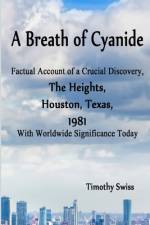av Timothy Swiss
297
On September 26, 1981, an employee from an industrial plant in the Timbergrove area of Houston, Texas had blood collected at a small medical clinic that was situated in a central-northwest community of Houston known as the Heights. The blood was positive for cyanide. On November 18, 1981, the employee's wife had blood taken that was also positive for cyanide. Thereafter, the Heights physician who conducted the blood testing, namely Timothy R. Oesch, M.D., began testing neighborhood residents. The residents also yielded positive tests for blood cyanide. Dr. Oesch had his own blood collected on a day when winds were blowing from the direction of the industrial plant, and his blood contained cyanide at a level of 104 mcg/dl. The industrial plant was situated two miles west of the clinic where Dr. Oesch's blood was collected. Patients seen by Dr. Oesch were suffering symptoms of cyanide poisoning and they improved with oral doses of sodium thiosulfate pentahydrate, an antidote. Meanwhile, the City of Houston Department of Health belittled Dr. Oesch's claim of environmental cyanide poisoning and suggested that the positive findings for blood cyanide were due to laboratory error. Severance and Associates Laboratories stood behind their findings; and consequently, Dr. Oesch obtained additional positive tests for cyanide from Mayo Clinic Laboratories, Bio-Science Laboratories, Metpath Laboratories, and National Medical Services; and another physician obtained a positive blood cyanide test from SmithKline Laboratories. Before responding to a call to active duty in the United States Navy in July of 1982, Dr. Oesch acquired one hundred positive tests for cyanide exposure in eighty patients. Some of these patients were from areas of Houston other than the Heights, such as the Spring Branch district. These one hundred positive tests did not include any positive tests for cyanide exposure that were ordered by other physicians, and also did not include any results from blood samples collected by the City of Houston Department of Health on December 2, 1981 which yielded numerous positive blood cyanide levels that were reported by the Harris County Medical Examiners Toxicology Laboratory with blood cyanide levels ranging as high as 36 mcg/dl. Dr. Oesch was certain then, as he is now, that airborne, atmospheric cyanide was poisoning his patients. The City of Houston found cyanogen chloride, a toxic war gas that causes cyanide poisoning, in industrial effluent that was discharged into the public sewer system, but this finding was kept secret from Dr. Oesch. Dr. Oesch did not find out about the cyanogen chloride until years later. Cyanogen chloride is very volatile, meaning that it will readily escape liquid and become airborne. An article published in The Houston Chronicle on December 6, 1981, stated that the only company in north Houston licensed to dump cyanide compounds was a General Electric distribution assembly plant at 3530 W 12th Street. Despite extensive evidence to the contrary, the City of Houston Department of Health continued to belittle the existence of environmental cyanide poisoning. After his experience in Houston, Dr. Oesch became involved with issues of airborne cyanide and ensuing illness in Philadelphia, Pennsylvania and parts of New Jersey, and then later in East Tennessee. He concluded that maladies and sufferings caused by exposure to atmospheric, airborne cyanide are widespread, affecting a significant percentage of the world's population. He found out, firsthand, what can happen to someone who addresses a problem involving billion or trillion-dollar industry as well as bureaucratic hierarchy. And in the final chapter of A Breath of Cyanide, another individual named Sherrie Farver shares her incredible undertakings in dealing with industry, illness, and politics associated with airborne cyanide. The events and discoveries presented in this book are authentic, as are the many scanned laboratory reports and documents.










